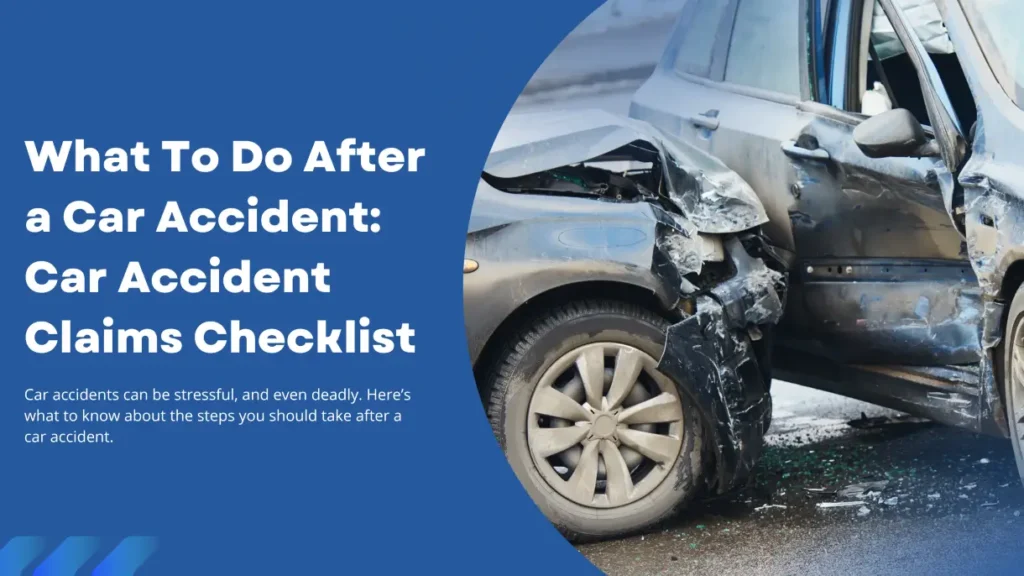Brakes slam, tires squeal, there is a moment of “oh no” and then a sickening crunch. If you’ve ever been in a crash, just reading that sentence probably feels triggering. Especially since everything surrounding a car accident is not only dangerous, but also stressful.
Whether it’s gathering evidence, contacting the right people, or filing a car accident claim, each step is crucial to safeguard your rights and future. This guide provides a clear, actionable car accident checklist for handling traffic accident claims, understanding the insurance claim process, and navigating the aftermath of a crash with confidence.
Ready to see if you may qualify? Click here to get a FREE, no-obligation consultation before starting your claim.
Key Takeaways: What To Do After a Car Accident
- Notify authorities to create a police report, which can support your insurance claim.
- Document the accident thoroughly, including photos, vehicle details, and witness information.
- Exchange information with other parties, such as insurance and contact details.
- Start the insurance claims process promptly to avoid delays in resolving damages or receiving compensation.
- Avoid admitting fault and let the police and insurance adjusters determine liability.
- Consult a lawyer if needed, particularly for cases involving serious injury or disputes with insurance companies.
Car Accident Checklist: Pre-Crash Must-Haves
Step One: Print this article and put it in the glove compartment of your car. We’re not kidding!
Emotions are typically at an all-time high when a crash happens. You may think you’ll remember all these steps in the heat of the moment, but odds are, you will not. Having something you can refer to will help keep you on track.
This is assuming that your injuries are minimal, or your car isn’t on fire. Obviously in severe cases, don’t worry about retrieving this list.
But if you’re in an accident and still functional, it’ll help to have this list and these other items handy:
- Keep copies of relevant auto documents in your car. That means your vehicle registration, auto insurance, policy agent’s name, and Driver’s License.
- Carry important medical information. While it’s not required for accident reports, it’s always a good idea to have ready for you and family members. This includes allergies, doctor’s numbers, and so on.
- Make sure your vehicle is emergency prepped. We’re talking flares, orange cones, and/or emergency signage. Also, consider keeping a flashlight, water, and blanket in the car.
- A notepad and pen. While everyone relies on tech toys today, sometimes they fail. If you’re in an accident, you’re going to need to write things down. And it’s better if you aren’t recording vital info on the back of a receipt or something.
By keeping all of these tools and resources on hand, you’ll be better equipped to act in a crash.
10 Steps to Take Immediately After a Car Accident
If the dreaded moment arrives that you’re in an accident, the first thing to do is try to stay calm. Easier said than done, we know. But it will help if you don’t panic, so you can take these methodical next steps:
1. Check for injuries.
This means you and any passengers in the car. The most important thing is making sure everyone involved is okay.
2. Call 911.
If there are any injuries, then you’ll want to get assistance on the way immediately. This will also notify the police, whom you need to help document the accident.
3. Move to safety.
If you can drive the vehicle, move it out of the flow of traffic. If the car is not impeding traffic, turn on the hazards/set flares and leave it where it is. Move yourself and passengers as far away from the roadway as possible but stay at the scene.
4. Wait for help.
Wait for the police and/or EMT. When they do arrive, ask for a card and their badge number. Only speak to officers who can show proper identification. Also ask how you can later get a copy of the police report for the accident.
5. Do not admit fault.
To legally protect yourself do not claim responsibility even if you think it was your mistake. Leave fault determination to the police and insurance companies.
6. Gather as much information as possible.
At the very least, make sure you get the other drivers involved:
- Full name, address, and contact info (phone number/email).
- Car registration and insurance ID card/policy number.
- Driver’s license and license plate number.
- Make, model, and color of vehicle.
7. Take lots of photos.
No, we don’t mean accident selfies (unless you’re recording injuries). But do try to get photos of:
- Damage to your vehicle.
- Damage to the other vehicle or vehicles.
- License plates of all cars involved.
- Skid marks, blown-out tires, or other potential causations.
- Surrounding landmarks like street signs, stop signs, trees, and anything that identifies the location.
8. Talk to witnesses.
If anyone has stopped to help or saw the accident occur, ask for their contact information. If possible, also get info from any passengers in the other car. These witnesses may offer important insights when determining liability.
9. Beware bandit tow trucks.
Don’t accept a tow from any truck you didn’t call. According to the National Insurance Crime Bureau, there are “highway bandits” looking for accidents. They then tow unknowing victims to unscrupulous repair facilities and charge exorbitant fees to get them back.
10. Contact your insurance company.
If you have time and aren’t too shaken, contact your insurance company while you wait. The sooner they know what happened, the more they can help. If you can’t do it at the scene, do this step as soon as possible to start your claim.
How to Navigate the Insurance Claims Process
Dealing with an insurance claim after a car accident can feel complicated, but understanding the process ensures your claim is handled smoothly. From notifying your insurer to getting your vehicle assessed, each step helps resolve the damage and protect your rights. Follow these guidelines to navigate the insurance claims process effectively.
1. Notify Your Insurance Company About the Auto Accident
Contact your insurance company immediately after the accident. Provide key details, including the police report, photos of the damage, and contact information for the other parties. Your insurer will assign a claims adjuster to review your case and guide you through the next steps. Prompt communication with your insurance agent is essential to avoid delays or complications in the claims process.
2. Review and Ask Questions About Your Insurance Policy
Take time to review your insurance policy to understand what is covered, including collision damage, rental cars, and medical expenses. If your car insurance policy includes transportation expense coverage, it can help pay for a rental car while your insured vehicle is being repaired. If you have questions about your coverage, discuss them with your insurance representative. Policies can vary significantly, and knowing your rights and responsibilities will help you manage the claim effectively and avoid unexpected out-of-pocket expenses.
3. Get an Estimate on the Damages and Repair Costs
Your insurance company will likely require a damage assessment to estimate repair costs and determine the actual cash value (ACV) of your vehicle. Schedule an inspection with their approved adjuster or repair shop. If additional damage is discovered during the repairs, the shop may contact your insurer for approval of added costs. Keeping detailed documentation of the estimates ensures transparency and fair settlement.
4. Get Your Car Repaired
Once the repair costs are approved, you can proceed with getting your vehicle repaired at an authorized repair shop. Depending on your policy, your insurer may pay the shop directly or reimburse you. Additionally, your policy may cover the cost of a rental vehicle while your car is being repaired. Confirm the repair shop’s process with your insurer to ensure the repairs meet industry standards and restore your car to its pre-accident condition.
Preventative Measures to Avoid Future Accidents
Preventing car accidents starts with preparation and safe driving habits. By staying proactive and ensuring your vehicle is in good condition, you can reduce the likelihood of being involved in a crash. Here are key preventative measures to help you stay safe on the road:
Practice Safe Driving Habits
- Follow traffic laws: Adhere to speed limits, obey traffic signals, and respect right-of-way rules.
- Avoid distractions: Keep your focus on the road by avoiding phone use, eating, or other distractions while driving.
- Maintain a safe following distance: Allow ample space between your car and the vehicle in front of you to give yourself time to react.
- Be mindful of weather conditions: Slow down and drive cautiously in rain, fog, or snow.
- Avoid aggressive driving: By knowing how to stay calm and avoid angering other drivers, you can stay safer on the road.
Keep Your Vehicle in Good Condition
- Schedule regular maintenance: Ensure your brakes, tires, lights, and wipers are in proper working condition.
- Check fluid levels: Monitor oil, coolant, and brake fluid levels to prevent mechanical issues on the road.
- Replace worn-out parts promptly: Address any issues with tires or essential components to keep your car safe to drive.
Stay Prepared for Emergencies
- Carry emergency supplies: Keep items like a flashlight, jumper cables, water, a first-aid kit, and a blanket in your car.
- Keep proof of insurance and important documents: Ensure your insurance card, registration, and driver’s license are readily accessible in case of an accident.
- Understand local traffic laws: Familiarize yourself with state-specific regulations, such as reporting requirements after an accident.
Retain an Auto Accident Lawyer
If the accident involved major damage or personal injury, it might be worth having a no-fee consultation with a lawyer. Frequently, insurance companies will try to settle claims quickly, but as a result, you don’t get the actual cash compensation you deserve.
The aftermath of an accident can sometimes feel as traumatic as the crash itself. That’s true even if you follow the car accident checklist to the number. If you find yourself overwhelmed while dealing with the repercussions, let us connect you with a lawyer who can help.
Ready to see if you may qualify? Click here to get a FREE, no-obligation consultation before starting your claim.

